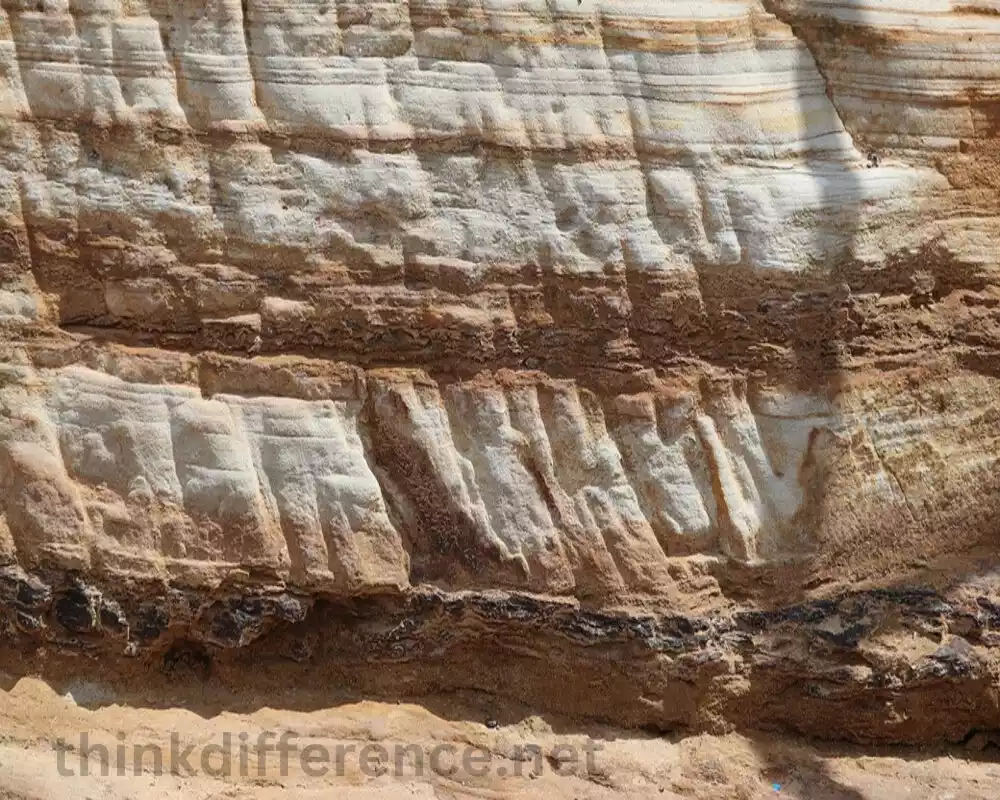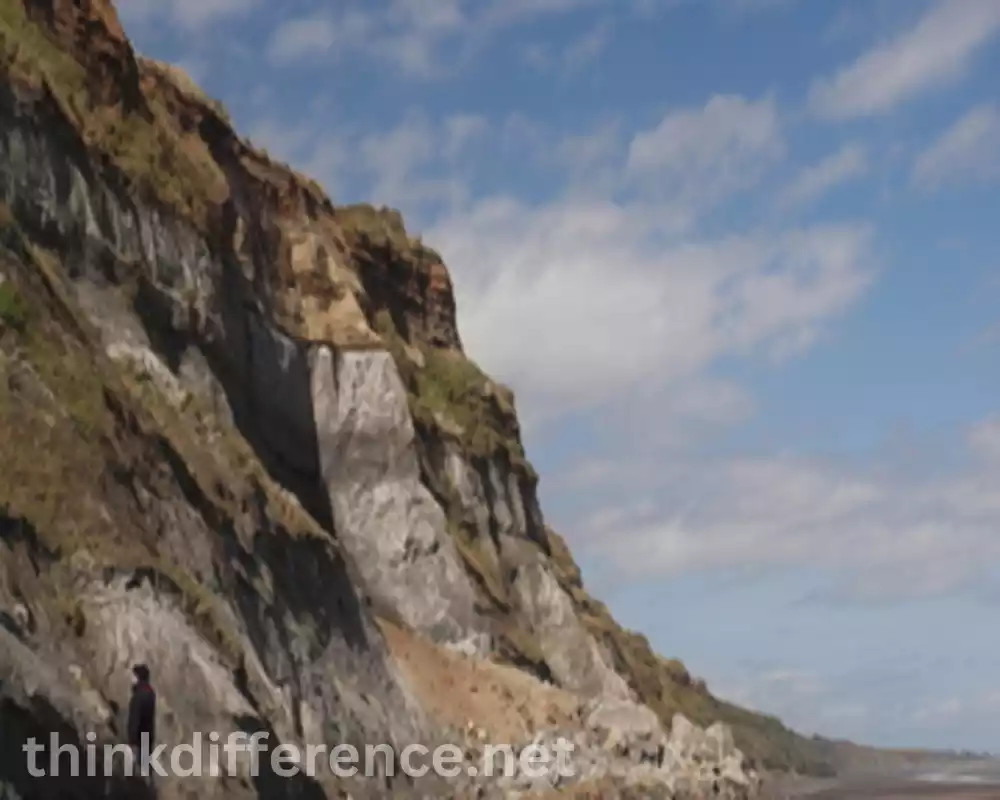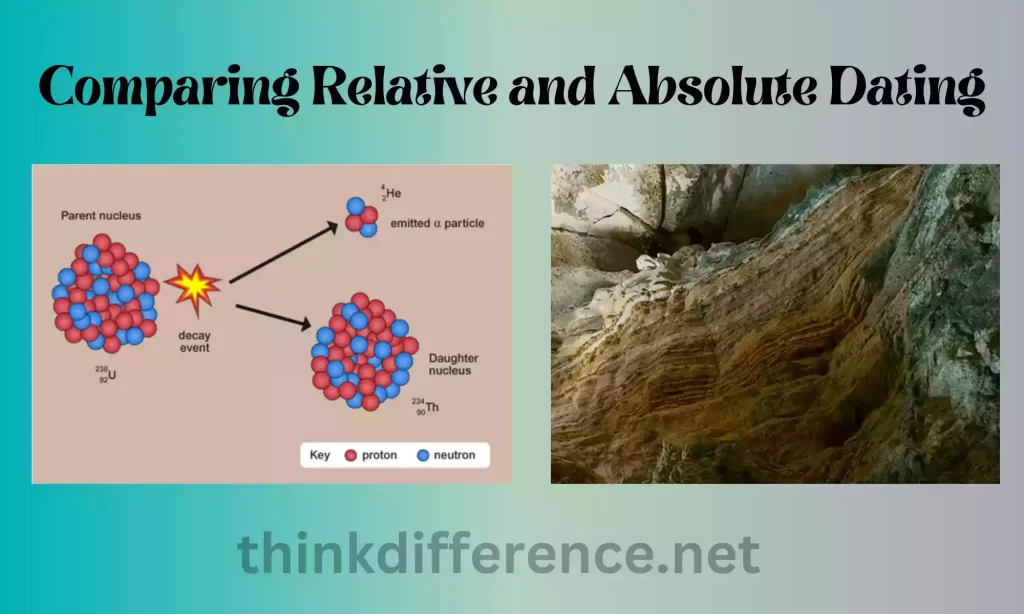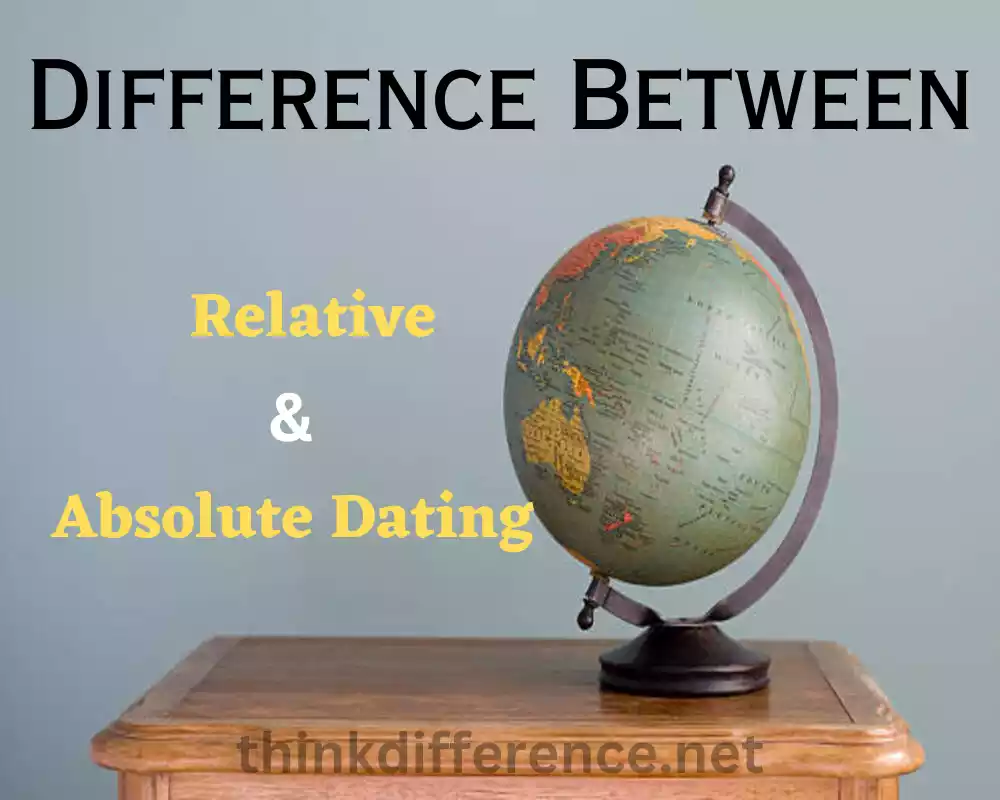Archaeology and other sciences use Relative and Absolute dating methods to assess the age of artifacts and fossils found within Earth’s past, which provide vital clues as to events shaping its history and evolution. In this article we’ll look at these dating concepts, their differences, and how they help us comprehend its past.
Definition of Relative dating
Relative dating is used in geology, paleontology and archaeology to establish the age of fossils, rocks and artifacts. It involves establishing the relative order of events or objects without assigning specific numerical ages. Instead of providing an exact age, relative dating places objects or events in a sequence based on their relationships to one another and to the surrounding geological or archaeological context.
This method relies on principles such as the law of superposition, the principle of original horizontality, the principle of cross-cutting relationships, and the principle of faunal succession to determine the relative age of different strata, rock layers, or artifacts. By examining the relative position and characteristics of these objects or events, scientists can construct a chronological framework and understand the sequence of geological or archaeological events that took place.
Relative dating allows for the comparison of different sites or stratigraphic sequences and helps in establishing a relative timeline of Earth’s history or human activities.
Definition of Absolute dating
Absolute dating is a scientific method used to determine the exact age of rocks, fossils, artifacts, or other geological or archaeological materials. Unlike relative dating, which establishes the order of events or objects in relation to one another, absolute dating provides a numerical age or age range for a specific object or event. Dating technology employs various scientific principles and methods in order to accurately calculate when something was created or occurred.
Radiometric dating is one of the most frequently employed absolute dating methods, using decay of radioactive elements as its basis. To calculate age using this approach, ratios are measured between daughter isotopes and parent isotopes in samples taken at different points during time. A known decay rate applies for radioactive elements. Different isotopes are used for different age ranges, such as carbon-14 dating for relatively young materials or uranium-lead dating for much older rocks.
Other absolute dating methods include dendrochronology (tree-ring dating), which uses the patterns of tree rings to determine the age of wooden objects; varve analysis, which relies on the annual layers of sediment deposited in lakes or ice cores; thermoluminescence dating, which measures the trapped electrons in minerals; and electron spin resonance dating, which determines the age of materials through their response to radiation.
Absolute dating provides a more precise estimation of age compared to relative dating. It allows scientists to assign numerical ages to geological events, the lifespan of organisms, or the duration of human civilizations. By using a combination of different absolute dating methods, scientists can establish a more comprehensive understanding of Earth’s history and the timeline of past events.
Importance of dating methods in understanding the history of Earth and its organisms
Dating methods play a crucial role in understanding the history of Earth and its organisms.
Here are some key reasons why dating methods are important:
- Establishing Chronological Frameworks: Dating methods provide a way to establish chronological frameworks and timelines. Scientists use them to track events chronologically and establish geological processes or important evolutionary movements that occur over time. This helps in reconstructing the history of Earth and its organisms.
- Understanding Geological Processes: Scientists use dating methods to study geological processes like rock deposition and formation, plate movement and volcanic eruption. By dating geological features and rock formations over millions of years, scientists can unmask how Earth was shaped over its history.
- Evolutionary Studies: Dating methods are essential for studying the evolution of life on Earth. By dating fossils, scientists can determine the age of ancient organisms and trace the patterns of evolutionary change over time. This helps in understanding the origins of different species, their relationships, and the pace of evolutionary processes.
- Climate and Environmental Reconstruction: Dating methods aid in reconstructing past climates and environments. Scientists use tree rings or ice cores as time capsules to assess temperature variations, atmospheric composition and ecological conditions over thousands or millions of years – providing key data needed for understanding past climate dynamics as well as anticipating future ones, and assessing human impacts on the environment.
- Archaeological and Cultural Studies: Dating methods are vital in archaeology and cultural studies. Archaeologists use dating technology to analyze artifacts and human remains from antiquities sites and museums, in order to reconstruct past cultures as well as understand technological advancement and social shifts in recent decades. Dating methods also aid in correlating different archaeological sites and establishing cultural connections across regions and time periods.
- Conservation and Preservation: Dating methods are used to determine the age and authenticity of cultural heritage objects, such as artworks, ancient manuscripts, or historical monuments. This information is crucial for conservation efforts, preservation planning, and the proper interpretation of cultural artifacts.
Dating methods provide the foundation for understanding the chronology, geological processes, evolutionary history, environmental changes, and cultural developments that have shaped Earth and its organisms. They are indispensable tools for scientists in various disciplines and contribute significantly to our knowledge of the past.
What is Relative Dating?
Relative dating is a method used in geology, archaeology, and paleontology to determine the order of events or objects without assigning specific numerical ages. It involves establishing the relative sequence or position of rocks, fossils, artifacts, or other geological or archaeological materials.

Principles of relative dating are based on the observation and interpretation of rock layers and their relationships to one another.
Here are some key principles used in relative dating:
- Law of Superposition: Under this principle, in an undisturbed succession of sedimentary rocks, the oldest will lie at the base and youngest at the surface. By examining the vertical order of rock layers, scientists can determine the relative ages of the rocks.
- Principle of Original Horizontality: This principle states that sedimentary rocks are originally deposited in horizontal layers. Any deviation from horizontal layers, such as tilting or folding, occurred after the rock formation. This principle helps in interpreting the relative positions of rock layers.
- Principle of Cross-Cutting Relationships: This principle states that any geological feature that cuts across or intrudes into another rock or feature is younger than the rock or feature it cuts across. For example, if a fault cuts through layers of sedimentary rocks, the fault is younger than the rocks it displaces.
- Principle of Faunal Succession: This principle is based on the observation that fossil organisms succeed one another in a definite and determinable order. By comparing the fossils found in different rock layers, scientists can establish the relative ages of the rocks based on the known order of fossil occurrence.
Stratigraphy, the study of rock layers and their relationships, is an important tool in relative dating. By examining the characteristics of sedimentary rocks, such as their composition, color, and fossil content, scientists can correlate rock layers from different locations and establish a relative timeline of events.
Relative dating allows scientists to understand the relative order of geological or archaeological events and construct a broad chronological framework. Information provided by archaeology provides invaluable details of Earth formation history as well as relative age of fossils and artifacts found therein. Relative dating does not provide specific numerical ages and is limited to establishing relative positions and sequences.
What is Absolute Dating?
Absolute dating is a scientific method used to determine the precise or numerical age of rocks, fossils, artifacts, or other geological or archaeological materials. Unlike relative dating, which establishes the order of events or objects in relation to one another, absolute dating provides a specific age or age range for a particular object or event.

There are several methods used in absolute dating, including:
- Radiometric Dating: Radiometric dating relies on the decay of radioactive isotopes. Measured isotope ratios between daughter isotopes and parent isotopes are measured and an age calculated based on radioactive decay rates of radioactive elements such as carbon-14 dating, potassium argon dating, uranium lead dating and rubidium strontium dating can provide accurate age measurements using radiometric dating techniques. Carbon-14 dating, potassium argon dating, uranium lead dating and rubidium strontium dating are among some of the more widely utilized radiometric techniques.
- Dendrochronology (Tree-Ring Dating): Dendrochronology involves studying the patterns of tree rings in wooden objects or the remains of trees. By comparing the ring patterns in a sample to master tree-ring chronologies, scientists can determine the exact calendar year in which the tree grew and the age of the sample.
- Varve Analysis: Varve analysis is used for dating sedimentary layers, particularly in lakes or glacial environments. Varves are annual layers of sediment deposited in a consistent pattern. By counting and analyzing the varves in a sediment core, scientists can estimate the age of the sediment layer and the associated events.
- Thermoluminescence Dating: Thermoluminescence dating is based on the principle that certain minerals accumulate radiation over time. When heated, these minerals release stored energy in the form of light. By measuring the amount of emitted light, scientists can determine the time that has elapsed since the last exposure to heat or sunlight, providing an age estimate for the material.
- Electron Spin Resonance Dating: Electron spin resonance (ESR) dating is used for materials that have been exposed to natural radiation. It measures the trapped electrons in crystalline structures, such as tooth enamel or quartz, and calculates the age based on the accumulation of radiation-induced defects.
These absolute dating methods provide numerical ages or age ranges, allowing scientists to determine the precise chronology of events, the age of fossils or artifacts, and the duration of geological or archaeological processes. By combining multiple dating techniques or using cross-checks, scientists can refine and improve the accuracy of age determinations.
Absolute dating is essential for understanding the precise timing of geological events, evolutionary processes, cultural developments, and environmental changes throughout Earth’s history. It provides critical information for reconstructing past timelines and refining our knowledge of the past.
Comparing Relative and Absolute Dating
Comparing absolute and relative dating techniques allows us to better comprehend their similarities and distinctions, as well as their mutual synergies when applied to rocks, artifacts, archaeological finds and geological materials.

Below are several key comparison points:
- Basis of Dating:
- Relative Dating: Relative dating relies on the principles of stratigraphy and the relationships between rock layers, fossils, or artifacts. It determines the relative order or sequence of events without assigning specific numerical ages.
- Absolute Dating: Absolute dating provides specific numerical ages or age ranges for objects or events. It is based on measurable properties of materials, such as the decay of radioactive isotopes or the counting of annual growth rings in trees.
- Age Determination:
- Relative Dating: Relative dating can establish the relative age of objects or events by placing them in a chronological sequence. It can determine which rocks or fossils are older or younger than others but does not provide precise numerical ages.
- Absolute Dating: Absolute dating provides precise numerical ages or age ranges for objects or events. It can determine the actual number of years since an object or event occurred.
- Accuracy and Precision:
- Relative Dating: Relative dating provides a relative chronological order but does not provide precise age information. It is less accurate and precise compared to absolute dating methods.
- Absolute Dating: Absolute dating methods provide more accurate and precise age estimates. They can determine specific ages or age ranges with higher precision.
- Application in Different Contexts:
- Relative Dating: Relative dating is commonly used in geological, paleontological, and archaeological studies to establish the relative sequence of events, determine the order of rock layers, or identify the relative age of fossils or artifacts.
- Absolute Dating: Absolute dating is used to obtain numerical ages or age ranges in various scientific fields, including geology, archaeology, paleontology, and anthropology. It is particularly useful for determining the ages of rocks, minerals, fossils, or artifacts.
- Complementary Nature:
- Relative and Absolute Dating: Relative and absolute dating methods are complementary and often used together. Relative dating establishes the relative sequence of events and provides a framework for interpreting geological or archaeological data.
- Absolute Dating: Absolute dating methods then provide precise age estimates to refine the relative chronology and establish numerical ages for specific events or objects.
Both relative and absolute dating methods are valuable in understanding Earth’s history, the evolution of life, and the development of human cultures. Relative dating establishes a relative timeline and helps interpret the sequence of events, while absolute dating provides precise age estimates for specific objects or events. By combining these methods, scientists can create a more comprehensive understanding of the past.
Case Studies and Examples
Case studies and examples showcasing the application of relative and absolute dating methods provide insights into their practical use in various scientific disciplines.
Below are a few notable instances:
- Case Study: Grand Canyon Stratigraphy (Relative Dating)
- The Grand Canyon in Arizona, USA, is a prime example of the application of relative dating through stratigraphy.
- The rock layers in the Grand Canyon represent millions of years of geological history.
- By studying the sequence and relationships of different rock layers, geologists have established a relative timeline of the canyon’s formation.
- The superposition principle allows us to identify relative ages of rock layers; those deposited at the bottom being more ancient while younger layers would lie towards their respective summits.
- Case Study: Carbon-14 Dating of Artifacts (Absolute Dating)
- Carbon-14 dating is a commonly used absolute dating method for organic materials.
- This technique relies on carbon-14 decay from organisms which were once alive.
- By measuring the ratio of carbon-14 to stable carbon-12 in a sample, scientists can determine its age.
- For example, carbon-14 dating has been used to date ancient artifacts such as wooden tools, paintings, and human remains, providing insights into human history and cultural developments.
- Case Study: Dendrochronology (Absolute Dating)
- Tree-ring dating is an absolute dating method which utilizes tree ring patterns in order to determine an object’s age or any changes within its environment.
- By analyzing the growth rings in tree trunks, scientists can establish a precise timeline of events, such as past climate patterns or the age of archaeological wooden artifacts.
- Dendrochronology provides an essential method for dating ancient structures such as Native American cliff houses in the American Southwest or medieval timber-framed buildings in Europe.
- Case Study: Radiometric Dating of Rocks (Absolute Dating)
- Radiometric dating techniques such as potassium-argon or uranium dating are frequently employed to establish the age of rocks and minerals.
- Uranium and lead dating has been used, for instance, to estimate the age of Earth’s oldest rocks – yielding an estimate age of around 4.5billion years.
- These methods are also suitable for dating volcanic eruptions such as Mount St. Helens. Helens in 1980, helping in understanding the timing and frequency of geological events.
These case studies demonstrate the practical application of relative and absolute dating methods in unraveling Earth’s history, dating artifacts, understanding past environments, and establishing precise timelines of events. They showcase the importance of dating techniques in various scientific fields, from geology and archaeology to paleontology and anthropology.
Conclusion
Relative and Absolute dating techniques offer valuable tools to unlock the mysteries of Earth’s history. The combination of both methods enables scientists and researchers to construct a detailed timeline of the planet’s past, revealing the wonders of ancient life and geological transformations.



